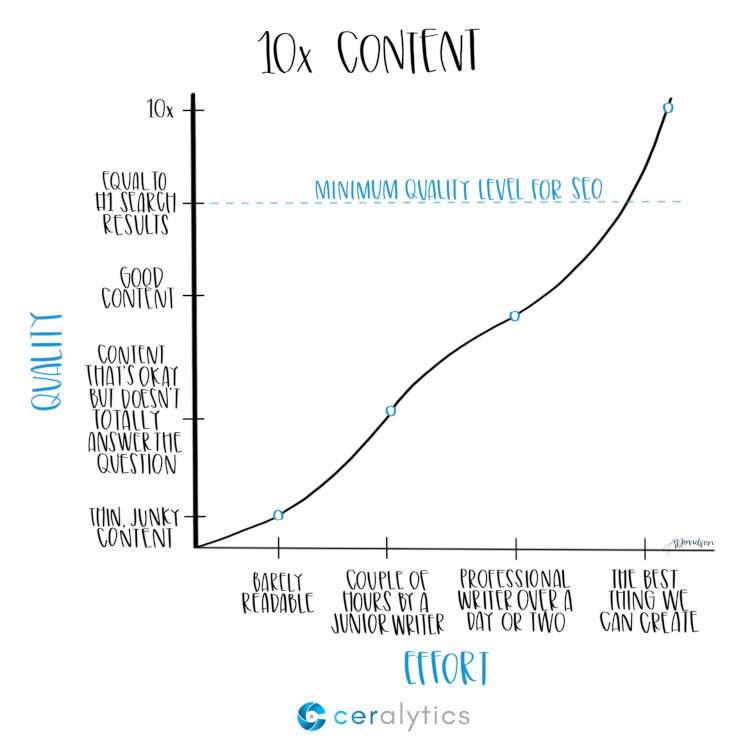It’s no secret that posting blog posts or articles on your business website are a great way to create the content you need to improve your site’s SEO strategy and connect with your audience on a more personal level. Many marketers make a mistake by prioritizing quantity over quality and releasing short pieces of content every day because they believe it will drive more traffic.
The Content Marketing Institute reports that 73% of B2B marketers think blog posts and articles are the most effective content types for generating demand at the awareness stage of the buyer’s journey or at the top of the sales funnel. And yet only 27% rated their company’s content marketing efforts as extremely successful or very successful. Where is the disconnect?
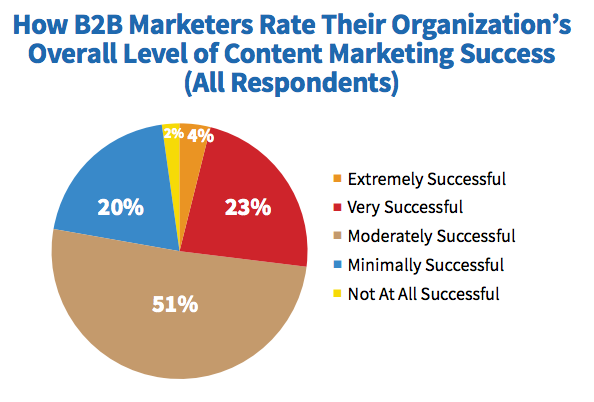
The truth is, creating a lot of high-quality content isn’t easy. There is a big difference between a business blog full of boring and uninformative posts and one that’s exploding with the kind of high-value content that naturally attracts readers.
Since you will obviously have better business results with the second scenario, you should take the time to create the pillar content that solidifies your blog’s reputation as a trusted source of good content in your industry.
What Is Pillar Content?
Pillar content is content that provides a complete answer to any question that a user may be looking for on a given topic. It is specifically designed to provide value to the reader and also to rank high in search engines.
Another name for pillar content is 10x content, which Moz’s Rand Fishkin describes as “content that is 10 times better than the highest-ranking result for a given keyword.”
The basic characteristics of the pillar content include:
- Solve a problem or answer a question with complete and accurate information.
- It differs in scope or details from other content on the topic.
- It is a combination of reliable, useful, or interesting.
With regards to business blogging, pillar content can also be defined as a series of posts that represent the best work on your site. These are the posts that you will be recommending new visitors to, as well as those that will continue to be useful to readers long after they are initially published.
Blog posts and articles are great examples of ideal pillar content, but infographics, videos, or other informational pages are also useful types of content that can be included on a pillar page to support the topic.
This foundational content provides important insight to anyone in your niche and, if done right, can be of value to your target audience in the near future, without losing relevance and always achieving a high ranking.
Benefits of Pillar Pages
The benefit of pillar pages for users is obvious: it provide all the information they are looking for on a topic in one place. But there are even more benefits for website owners, including:
More time spent on your site pages. The more content that is available for users to consume, the more time they will spend doing it.
A decrease in the bounce rate. If users find what they’re looking for on your page, they won’t go back to Google to find another source.
Backlinks and tons of social media actions. Pillar pages are shared widely and frequently, especially among influencers in a given space.
Get traffic for the life of your blog or website. Pillar content is perennial content, so its value does not decrease over time.
A high Google ranking. High word, action, and backlink counts will help improve visibility on SERPs.
As the pillar content goes beyond standard blog posts, it requires extra effort to develop. If you are interested in using this powerful business tool on your own website, check out the following 3-step process to create your own series of basic articles.
Step 1: Understand Your Audience
Creating basic content for your personal or business blog may seem like an individual search; after all, isn’t this an opportunity to express your innermost thoughts and most meaningful advice to your readers?
Well yes and no. Writing key content that is uniquely yours is important, but it’s even more important that the topics you’ve chosen to address resonate with your audience. If you have these essential articles to represent your business in the best possible way, it is important that they are of the greatest possible use to your readers.
To do this, you must first understand who your audience is:
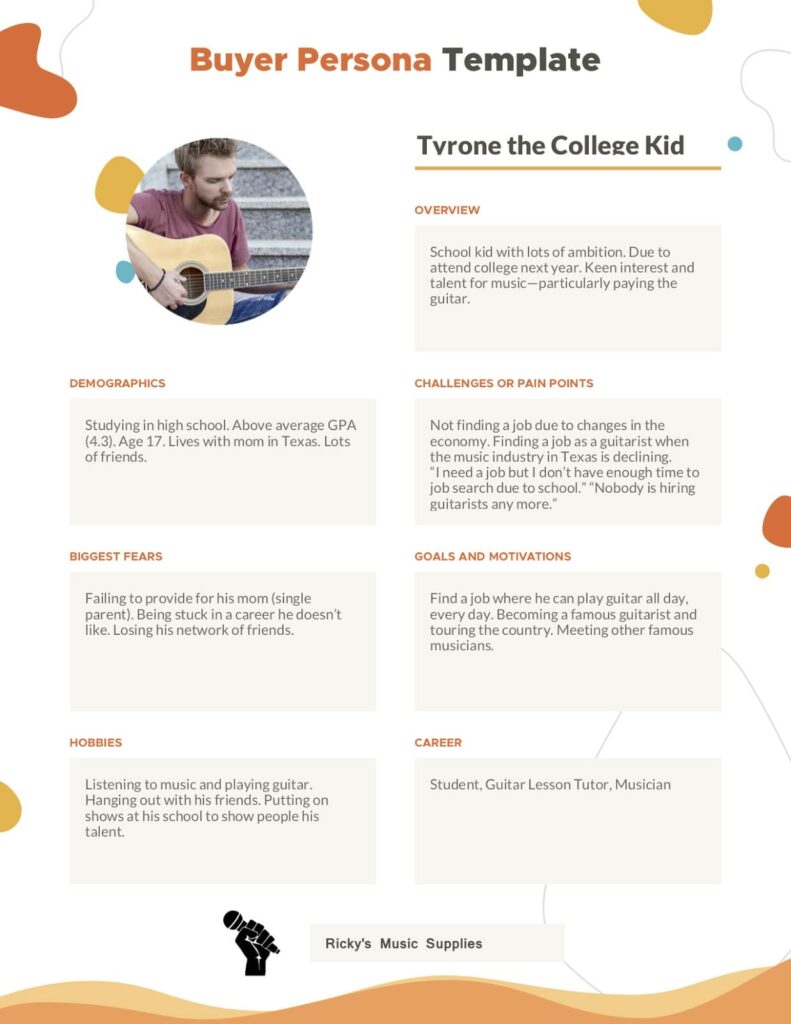
Take a look at your social media analytics tools, Google Analytics, and your CRM database to answer the following questions:
- Is my audience primarily male or female?
- What is the average age of the members of my audience?
- What ethnic groups do my audience members belong to?
- Where are my audience members geographically located?
- What do I know about the average education level of my audience?
- What is the average socioeconomic status of the members of my audience?
Answering these questions will give you an idea of how to best approach your audience in your pillar content posts, but you will need to do an even more thorough analysis on the next topic before you start writing.
Step 2: Identify Your Readers’ Most Pressing Needs
Now that you know who your audience members are, it’s time to uncover the issues on their minds, as understanding their pressing needs will help you develop relevant topics for each of your top posts.
There are several ways to use your audience to determine the best content ideas:
Are you a member of your target audience? In that case, try to remember how you felt and what you thought when you were a beginner in your industry. Think about the questions you had and the things you were most desperate to learn, and then use those ideas as the basis for your basic articles.
What are your audience members talking about on social media? If you’re not a member of your own target audience, you can still get an idea of their mindsets and interests by monitoring ongoing conversations on social media platforms, especially Twitter (try using Twitter’s Advanced Search) and LinkedIn. Read your followers’ posts and see which topics are mentioned, which articles are shared the most, and which messages are shared the most. This information should be a starting point for the production of your column articles.
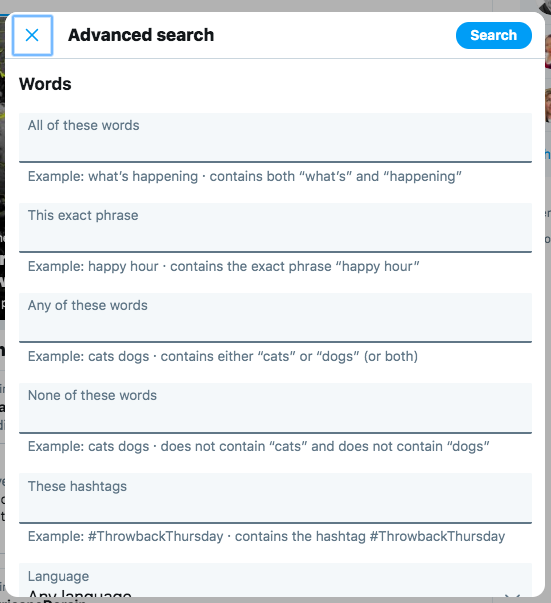
What kind of Piller content do other bloggers in your industry have? If you’re still having trouble finding topic ideas, take a look at popular content from your competitors. You can conduct competitive analysis using tools like SEMrush and Ahrefs. As long as your audiences are similar, topics that perform well on other sites in your industry are likely to translate well for your own audience (just make sure you don’t plagiarize!).
What type of presentation would be ideal for your target audience? There are several different types of pillar content with the potential to rank high and convey your information, including how-to guides, list-based posts, statistics-based posts, quick reference guides, and summary posts.
What are your user success gaps? In business, there is a gap between the desired outcome of the business and the outcome desired by the user, known as the success gap. For example, if you have a productivity app, the desired result is for people to download and use it. The desired outcome for the customer is to be more productive. LinkedInapplication alone will not make them productive: they may have bad work habits, time management problems, or be subject to procrastination. Addressing these gaps with content will help your existing customers succeed, and it will also attract new people struggling with similar issues – people who are likely to want to use your app.
Since you will invest significant resources in developing your pillar content, give some serious consideration to the specific topics you cover before moving on to the next step.
Step 3: Create Damn Good Content
At this stage in the process, you should have some ideas for pillar content pieces that meet the needs of your users, not just now, but in the future. Now is the time to start creating your staples!
As you get closer to the content creation process, remember that your base content articles need to be so useful and engaging that audience members feel compelled to bookmark your page and share it with their friends, family, and colleagues.
Headline: It’s been said a million times before, but remember that 80% of people will read a headline, while only 20% will click to read the rest of the blog post. This is the first thing people will see, so make it engaging, intriguing, and informative (no clickbait!).
Hook: More good news: Even after people click on your article, only 18% of your readers will read the entire article. Your lede (or hook), the one that grabs attention at the beginning of your blog post, should make the reader want to continue reading. Here are some good hooks:
- Interesting facts that they haven’t heard before
- An anecdote, a cliffhanger, or the end of a story
- A direct question that the reader resonates with
- A current events reference
Story: People love stories because it creates a human connection based on empathy. Just because you’re writing an article and not a novel, doesn’t mean you can’t use storytelling techniques in your post about how you built your podcast to 109,000 listeners a month. 🙂
Structure: Unless you are developing a new torture method, do not force your audience to read a 2000 word article that does not have titles, pictures, bullets, or paragraphs.
Research: Have you ever read an article that says something like “Most people have an iPhone”? It sounds legitimate, but if you do a little research, you will find that “62% of first-time mobile phone buyers tend to lean towards Android.” There’s no better way to lose your readers’ trust than not to back up what you’re saying with up-to-date and reliable research. This also applies to quotes, images, and statistics – always, always link to their source.
Action/Takeaway: Now that you have impressed the reader and performed a miracle by getting them to read your entire blog post, you need to tell them what you want them to do. Finish your game with a clear call to action, like “Get your free marketing tips” if you are a digital marketing agency:
Take the time to review and edit several drafts of your basic content posts before publishing, wondering each time if the content you are sharing is beyond what your readers expect. If you’re just producing the same content as everyone else in your industry, it’s not worth the effort.
Examples of Pillar Content
HubSpot: The Ultimate Guide to the Best Productivity Apps
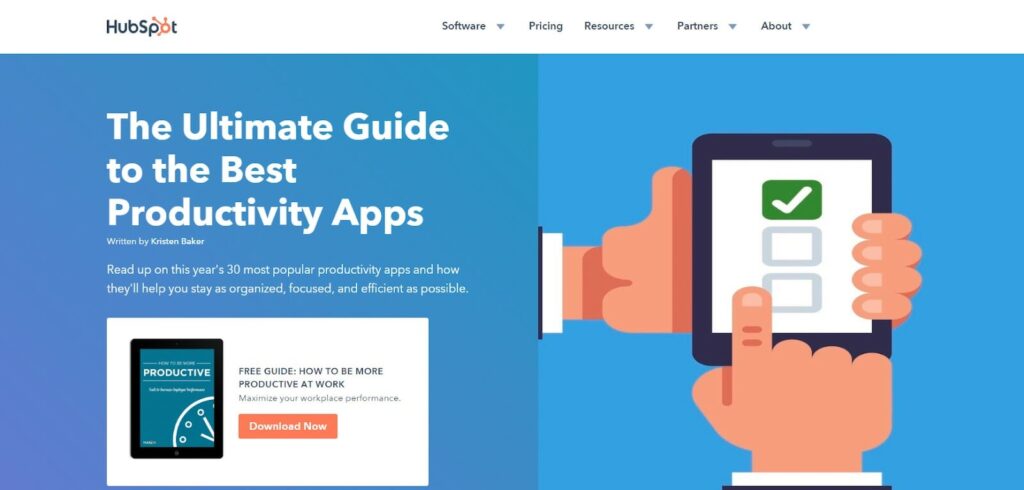
This is billed as a guidepost but is actually a list post. A long list of posts. The 30 apps that HubSpot chose to include are given a few paragraphs explaining the features, uses, and pricing of each. It is divided into categories as chapters to facilitate navigation:
In the post, they promote a closed guide to increasing productivity in the workplace, using the content of the pillar as a guide for the landing page. It’s smart: Someone reading a comprehensive guide to productivity apps is probably looking for ways to increase their own production. If these people find this content useful and trustworthy, they are ready to provide their contact information for more information.
Pillar Content Pays Off
So generally speaking, while it may take a lot longer to create your pillar content posts compared to the shorter blog posts you post on your business blog, you should find that extra search and referral traffic worth the effort. . It worked for us, and if you get it right, it will work for you too.

